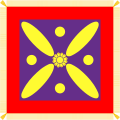 MESSENGER WAC mosaic | |
| Feature type | Impact crater |
|---|---|
| Location | Derain quadrangle, Mercury |
| Coordinates | 3°28′N294°41′W / 3.47°N 294.68°W |
| Diameter | 98 km (61 mi) |
| Eponym | Hakim Ferdowsi |
Firdousi is a crater on Mercury. It has a diameter of 98 kilometers. Its name was adopted by the International Astronomical Union (IAU) in 2010. Firdousi is named for the Persian poet Ferdowsi, who lived from 940 to 1020. [1]
- Firdousi from MESSENGER's third flyby in September 2009
- Approximate color image (map projected)
- Firdousi crater, showing hollows in the interior



